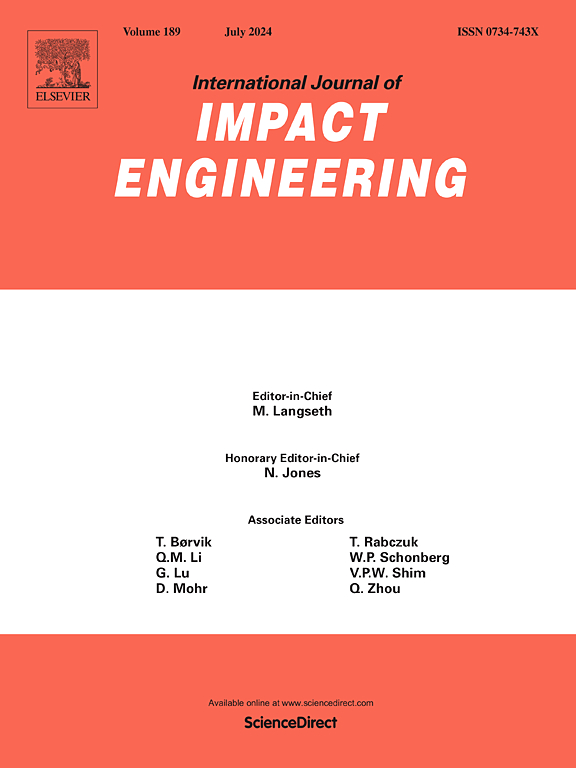Strain rate dependence of flow stress under ultrahigh strain rate conditions: A practical estimation method based on ball impact and indentation
IF 5.1
2区 工程技术
Q1 ENGINEERING, MECHANICAL
International Journal of Impact Engineering
Pub Date : 2025-06-13
DOI:10.1016/j.ijimpeng.2025.105435
引用次数: 0
Abstract
In most metallic materials, flow stress under plastic deformation increases significantly at ultrahigh strain rates above 104 s−1. However, measuring the strain-rate dependence of flow stress at ultrahigh strain rates is difficult when using the conventional split Hopkinson pressure bar (SHPB) method. We propose an advanced ball-impact indentation method for estimation of strain-rate dependence (referred to as BIM). BIM was previously verified using finite element analysis (FEA) with a Johnson–Cook flow stress model. However, it is uncertain whether BIM can accurately estimate the change in strain-rate dependence at ultrahigh strain rates. In this study, FEA with a bilinear Johnson–Cook (BJC) model was performed to verify BIM at ultrahigh strain rates. Consequently, the averaged flow stresses estimated by BIM using the FEA results were in good agreement with the input BJC model, even at ultrahigh strain rates. Further, ball impact and indentation tests were conducted for validating BIM. The averaged flow stresses estimated by BIM were close to the results of conventional uniaxial tests based on the SHPB method. In addition, the results indicated that a ball impact test using a small ball with a diameter of 1 mm at an impact velocity of 100 m/s could achieve an ultrahigh strain rate of >105 s−1. BIM adequately detected the change in the strain-rate dependence at an ultrahigh strain rate.
超高应变率条件下流动应力的应变率依赖性:一种基于球冲击和压痕的实用估算方法
在大多数金属材料中,在104 s−1以上的超高应变速率下,塑性变形下的流动应力显著增加。然而,采用传统的分离式霍普金森压杆(SHPB)方法测量超高应变速率下流变应力的应变速率依赖性是很困难的。我们提出了一种先进的球冲击压痕方法来估计应变率依赖性(称为BIM)。BIM之前使用Johnson-Cook流动应力模型的有限元分析(FEA)进行验证。然而,BIM能否准确估算超高应变率下应变率依赖关系的变化尚不确定。在本研究中,采用双线性Johnson-Cook (BJC)模型进行有限元分析,以验证BIM在超高应变率下的有效性。因此,即使在超高应变率下,BIM使用FEA结果估计的平均流动应力也与输入的BJC模型非常吻合。此外,为了验证BIM,还进行了球冲击和压痕试验。BIM估算的平均流变应力与基于SHPB方法的常规单轴试验结果接近。此外,结果表明,使用直径为1 mm的小球在100 m/s的冲击速度下进行球冲击试验,可以获得>;105 s−1的超高应变率。BIM充分检测了超高应变率下应变率依赖关系的变化。
本文章由计算机程序翻译,如有差异,请以英文原文为准。
求助全文
约1分钟内获得全文
求助全文
来源期刊

International Journal of Impact Engineering
工程技术-工程:机械
CiteScore
8.70
自引率
13.70%
发文量
241
审稿时长
52 days
期刊介绍:
The International Journal of Impact Engineering, established in 1983 publishes original research findings related to the response of structures, components and materials subjected to impact, blast and high-rate loading. Areas relevant to the journal encompass the following general topics and those associated with them:
-Behaviour and failure of structures and materials under impact and blast loading
-Systems for protection and absorption of impact and blast loading
-Terminal ballistics
-Dynamic behaviour and failure of materials including plasticity and fracture
-Stress waves
-Structural crashworthiness
-High-rate mechanical and forming processes
-Impact, blast and high-rate loading/measurement techniques and their applications
 求助内容:
求助内容: 应助结果提醒方式:
应助结果提醒方式:


